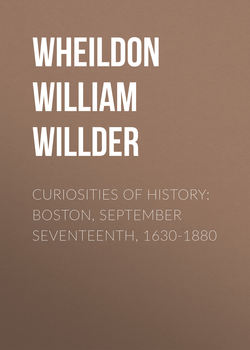Curiosities of History: Boston, September Seventeenth, 1630-1880

Реклама. ООО «ЛитРес», ИНН: 7719571260.
Оглавление
Wheildon William Willder. Curiosities of History: Boston, September Seventeenth, 1630-1880
INTRODUCTION
I. TOPOGRAPHY OF BOSTON
II. THE PUBLIC FERRIES
III. THE BOSTON CORNFIELDS
IV. PURITAN GOVERNMENT
V. THE NARRAGANSETT INDIANS
VI. NAMES OF PLACES, STREETS, ETC
VII. PERSECUTION OF THE QUAKERS
VIII. FIRST NEWSPAPER IN AMERICA
IX. CURIOUS BOSTON LECTURES
X. REMARKABLE PROCLAMATIONS
XI. POPULAR PURITAN LITERATURE
XII. REVOLUTIONARY PROCLAMATIONS
XIII. CURIOSITIES OF THE MARKET
Отрывок из книги
There is a line of Cowper to the effect that “God made the country, and man made the town;” and there is probably no more striking evidence of the truthfulness of the axiom than is to be found in the history and growth of Boston, between the years 1630 and 1880, confirming in a remarkable manner Capt. Wood’s prophecy concerning the town, in 1650: viz., “whose continuall inlargement presages some sumptuous city.” The original territory which has formed the basis, so to speak, of Boston proper, was a peninsula, and appeared like two islands, or, by the continued operation of the sea, was likely to become so. Its distinguishing feature was to be found in its three prominent hills, or, perhaps, its two hills and its three-peaked mountain. These were her jewels: they have since represented her fame, her history, her sentiments; for these were all wrapped around them. The peninsula was a point of land projected into the harbor, with a narrow neck connecting it with the mainland, and another narrow place in the vicinity of what is now Dock Square, which was once quite open to the harbor. In length from the south line at Roxbury, it was something less than three miles (two and three-fourths and two hundred and thirty-eight yards). Its width at the widest point, between Wheelwright’s wharf (afterwards Rowe’s, and now Foster’s) to Barton’s Point, Leverett Street, was something over one mile, and its circumference about four miles.
The first impression of the “island” which has been recorded is that of Anne Pollard, who died in Boston, Dec. 6, 1725, at the age of 105 years, and left over one hundred descendants. She always said that she came over from Charlestown, in 1630, in the first boat that crossed with Gov. Winthrop’s party, and, being what might now be called a romping girl for those times, ten years of age, was “the first to jump ashore;” and she afterwards described the place “as being at that time very uneven, abounding in small hollows and swamp, and covered with blueberry and other bushes.” We do not think there is any one inclined to dispute this statement, or question its truthfulness.
.....
The Creek, or the Mill Creek, as it was afterwards called, was undoubtedly prior to the formation of the Mill Pond; and it is doubtful if it was ever included in it, although Shaw conveys the idea that the North Cove was simply a piece of salt marsh, and that the creek was used for the purpose of covering it with water at flood-tide, and thus forming a mill-pond. As early as the 5th of July, 1631, an order was passed by the Court of Assistants, “that £30 be levied on the several plantations for clearing a creek, and opening a passage to the new town,”—the town at this time being the settlement around the South Cove; so that the “clearing of a creek” was “a work of industry” on a small scale for such an enterprise. It was made across the narrow neck of land between the two great coves, and while it united the waters of Charles River with the harbor, divided the peninsula into two islands or sections. The creek, whatever its relations may have been to the Mill Pond in the later years of its existence, was used by the boats coming from the Middlesex Canal, which terminated at Charlestown Neck, and furnished to them a shorter way to the harbor with their freights of wood, lumber, &c. A few extracts from the town records will afford some further insight into the character and uses of the creek.
In 1648, in describing the property of Thomas Marshall, who owned some land near the Water Mill, Mill Creek, it is stated, “with liberty of egress and regress in said creek with boats, lighters, and other vessels;” and it is added, “Thomas Marshall shall not build any nearer the creek than the now dwelling-house of said Milom, and that he shall not hinder the mills going by any vessel in the creek.”
.....